Guadeloupe used to be very expensive to reach. That changed when Norwegian launched service for winter travel in December 2015. As a result, if you buy your ticket early enough, it is very easy to jet down to Guadeloupe for about $200, even during the middle of our winter. Our friend, Cynthia, who goes to a lot of places and takes awesome pictures, went earlier this year — we aspire to go to all of the interesting places that she has been. Here are her practical tips.
If you would like to write about your recent travel experiences on The Flight Deal, submit your pitch here.
=
There’s one big problem when it comes to visiting the French Caribbean and that’s how much of the best travel information on the islands is in French. Sure, you could plug it all into Google Translate, bit by bit, or you could just read on for some insights I gained when I headed down to Guadeloupe with a group of friends, all convinced by Norwegian Air’s cheap fares to take a chance on a new (to us) vacation destination.
To prep for your own visit with a little extracurricular eye candy, hop on Netflix and watch the BBC who-done-it crime series “Death in Paradise.” Though the action supposedly takes place on a fictional island off the coast of Guadeloupe, it was filmed on the island proper—chiefly in the town of Deshaies.
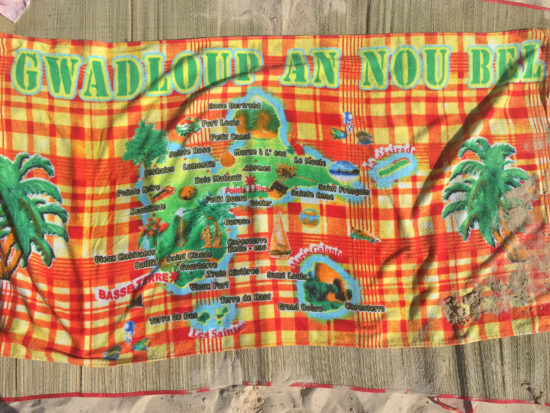
Guadeloupe – Photo: (c) 2016 – Cynthia Drescher
GETTING IN
In addition to the Norwegian Air flights from New York, Boston, and Baltimore, PTP sees arrivals and departures from Air France (Paris, Haiti), Alitalia (Rome, Milan), American Airlines (Miami), XL Airways (Paris), Corsair (Paris), Air Caraibes (Martinique, St. Martin, Haiti), Air Antilles (Martinique, St. Barths, St. Martin, Santo Domingo), Winair (Dominica), LIAT (Antigua, Barbados), Air Canada (Montreal), and the occasional Seabourne Airlines codeshare with American Airlines and JetBlue (San Juan). All of this is subject to change, especially depending on the season.
Additionally, it is possible to reach Guadeloupe via ferry from Martinique, Dominica, and St. Lucia.
Guadeloupe’s Pointe-a-Pitre/Le Raizet International Airport (PTP) is shockingly nice, with modern architecture, air conditioning, and a wing specifically for the rental car counters. Any departure fees are included in your Norwegian Air ticket, and check-in is easy though your baggage will likely be weighed and eyeballed to comply with Norwegian Air baggage allowances. The airport agents speak English and French.
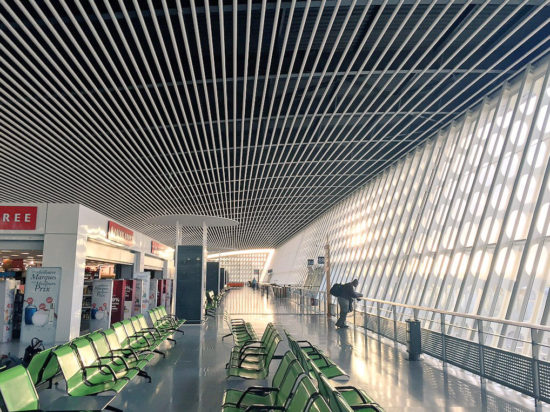
Pointe-à-Pitre International Airport, Guadeloupe – Photo: (c) 2016 – Cynthia Drescher
Scan your boarding pass to enter the security area, go through security and passport check, and then you’re in a small but very nice duty-free shop. We grabbed a few European candy bars and some local rum, and then paid a very reasonable 4.00€ for a ham and cheese baguette sandwich from the coffee shop counter across from the gate. Remember that Norwegian charges for everything on board (even water), so this is your last chance to stock up on cheap snacks before boarding.
CONNECTIVITY
T-Mobile’s free international data is your best friend on Guadeloupe as the island is one of the 115 countries covered by a Simple Choice plan. I simply flipped on my phone after landing, and T-Mobile texted me two messages: one saying texts were free and voice calls would be $0.20 per minute, another saying data was free as part of my plan. Sweeeet.
The two major cell carriers on the island are Orange and Digicel; T-Mobile will connect to the latter and coverage around the island is excellent. Two of our group purchased international data for their AT&T plans and sucked up most of it on the first day while trying to share Snapchats. Another attempted to get a local Orange SIM card from the stall at the airport, but the associate noted that only residents with local ID cards could purchase data plans. In the end, my T-Mobile data saved the day.
As for WiFi, vacation rentals will specify whether or not they have WiFi. Our Airbnb villa had fast, free WiFi and we encountered no problems. Check with your hotel or guesthouse for their individual WiFi situation. The McDonald’s along the highway between the two islands has free WiFi and is a valuable bathroom break stop, but don’t expect WiFi at restaurants, stores, and beaches.
MONEY MATTERS
As Guadeloupe is France in the Caribbean, the island operates on the Euro. Bring any Euros you have leftover from travels in Europe, or hit up an ATM for fresh bills. The airport arrivals area and town centers have ATMs.
Roadside restaurants, beach vendors, and mom-and-pop souvenir shops only accept cash, therefore making change could prove difficult, so break your big bills while shopping at larger stores (like the Carrefour supermarkets). Credit cards are surprisingly accepted at most other restaurants and stores, and we only ran into problems when paying with cards without chips (pack your chip-enabled credit cards with no foreign transaction fees!) or with shop owners who were too lazy to run a credit card (seriously).
Prices run the gamut, depending on what you’re buying. A fresh baked baguette is 0.95€, a bottle of the local Corsaire beer is 2.00€, and a huge lunch of BBQ chicken and sides at a beachside bistro is 12.00€ per person, but sashaying into a pharmacy to buy a bottle of La Roche-Posay sunscreen still commands upwards of 25.00€ and a bottle of French wine with dinner in a restaurant is the same pricing as you’d find in a big city.
GETTING AROUND AND SAFETY
I felt very safe on Guadeloupe and made fumbling efforts to use elementary French to start interactions with locals. Luckily one in our group was conversational in French, so more complicated matters (like speaking about ferry schedules to nearby islands) we left to her. Guadeloupe is as traditionally laid-back as the rest of the Caribbean and toplessness does occur on the beaches, but it is not sexualized. The most you can expect to be harassed on beaches and in town is by roving vendors of fresh-made coconut sorbet looking to sell their wares before it melts.
There are three options for getting around Guadeloupe: rental car, bus, and taxi.
Rental car:
This is your number one best bet for getting around the island in any sort of affordable, efficient manner (and I say this as someone who typically defaults to public transportation). For the Southern Caribbean, Guadeloupe is a comparatively large island with locations of interest spread far apart.
Since Guadeloupe caters to European travelers, their rental cars are almost all manual transmissions. In order to secure one of the few automatics on the island, place your rental request as early as possible (and be prepared to pay a little more per day). For example, our group was split into two car rentals: Sixt and Avis. The Sixt reservation was done weeks ahead of the trip, and the keys to an automatic VW Polo were waiting at the rental desk at the airport. The Avis reservation, however, was done several days ahead of the trip and, upon arrival at the Avis counter (after a lengthy line wait), we were met with a mix-up and the apology that only manual transmissions were left. In the end, we checked with every other car agency at the airport and *none* had any automatics available. Luckily we were able to simply sign on as an extra driver on the Sixt rental and all 5 of us squeezed into the one car.
As for driving, the roads are excellent and even get up to a multi-lane highway when driving through Point-a-Pitre and between the two islands. There are no toll roads or parking fees in public lots near beaches, town centers, or most any other place you’ll find yourself wanting to park. The small lot at the Cascades aux Ecrevisses is a tight fit with large tour buses and waiting taxis, so be assertive when it comes to snagging a spot.
Google Maps does not support turn-by-turn directions on Guadeloupe and so one of us in the car served as a navigator, giving directions to the driver as the little blue dot on Google Maps (our position) traced the estimated route. Google Maps was an enormous help, but we did find ourselves directed to turn off into a private road or cow pasture one too many times, so use common sense.
Bus:
There are buses with nice, shaded bus stops, but it may take you a couple hours to reach your destination as the schedule seems fluid. The most popular routes seems to be from Point-a-Pitre city to Deshaies or the capital of Basse-terre, rides which cost from 5 to 10 Euros each way. Still, you’ll have to get yourself to and from the bus stations for wherever you want to go. Bus drivers only speak French and Creole.
Taxi:
If you plan to go to a hotel or vacation rental and stay within that area for your whole trip, then perhaps renting a car isn’t necessary. In this case, you’ll be calling a taxi. Caribya has a list of companies and phone numbers (http://caribya.com/guadeloupe/taxis/), since the only place you’ll find taxis waiting for fares is at the airport…if they haven’t all already been taken. Be armed with multiple phone numbers and some French phrases for saying what you want. Taxis are quite pricey but are metered. For example, a simple 20-minute drive we did many times in our rental car, from Sant-Francois to Sainte-Anne, is approximately $40 one-way in a taxi.
FOOD AND DRINK
Staying in an Airbnb villa, we mostly hit up the massive Carrefour supermarket in Point-a-Pitre or the smaller Carrefour Express in the town of Saint-Anne. At these, fresh-baked baguettes are always at hand for mere pennies (okay, maybe like $0.35 each), and everything else is the typical grocery store fare of a French city. As for beverages, if you aren’t drinking French wine or local beer, then you better know how to make up a glass of *Ti Punch* (rhum agricole, sugar, lime).
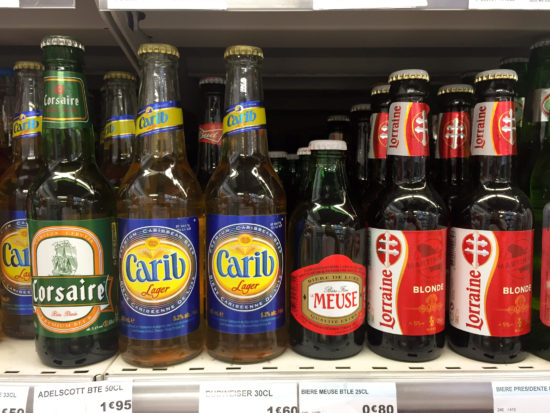
Beer at Carrefour, Guadeloupe – Photo: (c) 2016 – Cynthia Drescher
Le Mabouya dans La Bouteille in Sant-François:
This was the only real restaurant with a full menu we dined at during our visit, but we’d obviously made an excellent choice. Fellow diners were locals or loyal return visitors to the island. A lengthy French wine list and a menu with appetizers, specials, and desserts made this our fanciest, most formal meal on Guadeloupe.
Coco Nack on the Plage du Bourg de Sainte-Anne (see below for more on the beach):
When you just want some fried fish or chicken and a beer to get you through a beach day, go straight to Coco Nack. It’s a teensy-weensy shack only large enough for a small kitchen, with four to five tables outside under umbrellas and barely 20 feet from the sand of the beach. A chalkboard has a listing of the day’s specials, and the Coco Nack cat will happily wait beside you to eat whatever scraps you don’t finish.
Chez Loulouze on the Plage de Malendure (see below for more on the beach):
There’s a few restaurants with their tables in the sand on the Plage de Malendure, but Chez Loulouze had the most attentive service, as well as very affordable lobster on the menu.
Au Widdy’s in the Marina of Sant-François:
This tiny, locally owned restaurant in the marina faces the water and specializes in local seafood (but they’ll also do a burger). Widdy is the chef and enjoys getting to know his diners over generous pours of whatever aperitif bottle he has open. Au Widdy’s was also one of the only restaurants we found open beyond 9 p.m., but don’t take that as a rule.
ACTIVITIES
Beaches:
Yes, Guadeloupe has beaches. In fact, the island is so rife with beautiful, unpolluted, and pleasant (and free!) swimming beaches that it is a wonder it’s not more crowded. Some vacation rental communities have their own beaches, but the public ones are splendid enough. Learn these words: *plage* (beach), *anse* (cove), *plongée/plongeur* (diving/diver), and *sable* (sand).
Simply driving near the south coastline of Grande-Terre or western coastline of Basse-Terre will reveal many beaches, but here are five to note:
Grand Anse, Basse-Terre:
The largest and most popular beach, located at the northwest edge of the island of Basse-Terre. It’s a long stretch of golden sand and home to the highest percentage of beach vendors to sunbathers.
Plage de Malendure, Bouillante, Basse-Terre:
On the west side of Basse-Terre and home to the scuba shops and the offshore Cousteau marine reserve. Rent kayaks on the black-sand beach and paddle out to the nearby Pigeon islands to snorkel the reef (15 Euro snorkel gear rental), or just kick back on the beach and enjoy what we ranked as the best swimming of our time on Guadeloupe (no current, calm, perfectly clear water, sand bottom, and not too shallow or too deep). A few casual beachside restaurants with tables in the sand and open-air wood terraces do barbecue crayfish, lobster, chicken, and pork (Chez Loulouse was our pick). Not crowded, easy parking on the road side, and has a tiny information center with pamphlets about activities on the island. If you speak French, ask at the information center for directions to a small hot spring bath nearby. This is a volcanic island, after all, and the town’s name of Bouillante means “boiling.”
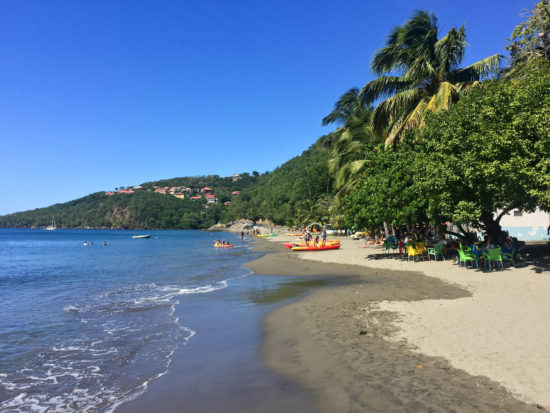
Plage de Malendure, Guadeloupe – Photo: (c) 2016 – Cynthia Drescher
Plage du Bourg de Sainte-Anne, Grande-Terre:
This municipal beach for the town of Sainte-Anne is a slice of heaven for beachgoers who appreciate convenience. Not only is the town center within strolling distance (a post office! banks! patisseries! a Carrefour Express!), but the beach is bordered by an open-air market of fresh fruits, handmade souvenirs, and street food vendors. The lovely long beach has a sailing school at one end, so the swimming zones are marked off with buoy ropes. We spent most of a day here, swimming in the calm, reef-protected waters, and there was quite a current pulling down the shore. It wasn’t dangerous; if you held onto a swimming area rope and relaxed, it was like fluttering in the wind on a flagpole. 10/10 would float again.
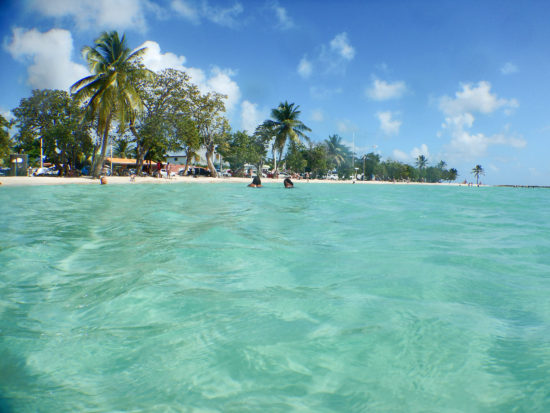
Plage du Bourg de Sainte-Anne, Guadeloupe – Photo: (c) 2016 – Cynthia Drescher
Plage de Raisins Clairs, Grande-Terre:
Tucked behind the soccer field stadium in the town of Sant Francois is this beach with a bit more wave action and a bit less people activity; the beachgoers are mostly locals who stay until dusk. We recommend staying for sunset, having a Coco Ti Punch aperitif at the palapa-roof bar at the eastern end of the beach, and then heading into the Saint Francois harbour for dinner at one of the quayside restaurants serving fresh-caught seafood (we recommend Au Widdy’s for casual and Le Mabouya dans La Bouteille for something a little nicer).
Pointe Tarare, Grande-Terre: As this is the French Caribbean, all beaches are moderately naturalist (read: nudist). Men wear tiny speedos and women have their tops off, but it’s rarely a sight you’ll relish. For the serious nudists, Pointe Tarare is supposedly *the* nude beach on Guadeloupe. We did not go, but it is near the hike at Pointe des Chateaux (see “Hiking” below) at the southeastern edge of the island of Grande-Terre.
Scuba diving/snorkeling:
Guadeloupe may not be one of the top destinations for scuba or snorkeling in the Caribbean, but it is available. As a keen diver, I combed scuba message boards and blogs looking for reliable, somewhat up-to-date information on dive shops and rates and was left wanting. I did know, however, that most of the action takes place in the Reserve Cousteau (yes, named for Jacques Cousteau) and the reef around the tiny Pigeon Islands off the Plage Malendure, on the west side of Basse-Terre. The beach is beautiful (see listing above) and has several beachside shacks offering kayak rentals, snorkeling gear rentals, and scuba trips. The most legit operation is Les Heures Saines (http://www.heures-saines.gp), located at the bend of the road at the southern end of the beach. The shop is small but scenic, a collection of terraces down the side of a small cliff, and a private dive boat dock. Although the dives for the day were already full up and I was unable to go out, I did speak with two staff who were both helpful and fluent in English. Having been diving on a French island (St. Martin) in the past, with others who speak only French, the language barrier can be isolating. At least we all speak the same language underwater!
Hiking:
There are plenty hiking routes on Guadeloupe to fill a week’s vacation (see some here: http://www.antilles-info-tourisme.com/guadeloupe/tracesgb.htm), but here are three to start you off:
Easy: Cascade Aux Ecrevisses (Crayfish Falls), Basse-Terre
Driving from Pointe-a-Pitre through to the western edge of the island (to the towns of Deshaies or the Plage Malendure) means passing the pull-off for Crayfish Falls, whether you plan to or not. You’ll know it by the taxis and tour buses parked in a small lot notched off the two-lane road, and it’s definitely worth a quick visit. Come ready to swim, however; the short, stone-paved walk to the falls is nice but not nearly as pleasant as separating from the tourists on the path to venture into the water. The waterfall is cool, fresh water, with a swimmable pool at the base and a nearby stream with smaller wading pools. Wear swim shoes and bring your own towel.
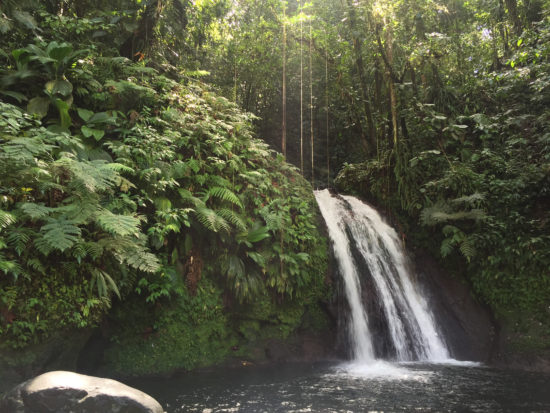
Cascade Aux Ecrevisses, Guadeloupe – Photo: (c) 2016 – Cynthia Drescher
Moderate: Pointe des Chateaux, Grande-Terre
The southeastern tip of the island is an environment given over to the wind and the waves, and a perfect hiking trail for a scenic view of the craggy coastline and the small, nearby island of La Desirade. Wear something studier than flip-flops, but leave the hiking poles behind; the trail is well-trod, with steps built into some portions. Take a deep breath and some selfies at the top, near the cross at the cliff top, but don’t plan on swimming in the turbulent waters and crashing waves of the beaches on either side. The reward of this path is pure scenery.
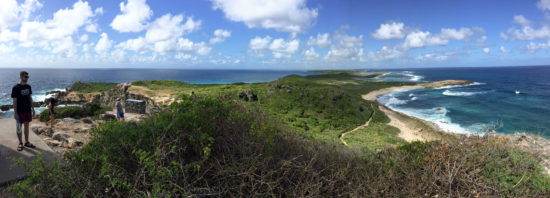
Pointe des Chateaux, Guadeloupe – Photo: (c) 2016 – Cynthia Drescher
Difficult: Chutes du Carbet (Carbet Falls), Basse-Terre
There are three waterfalls to see along this trail within the National Park, with the hike increasing in difficulty as it progresses. Destination360 has a full write-up on the hike, but its location on the side of La Soufriere volcano and within a rainforest means you should prepare for wet, uneven terrain and mercurial weather.
Island-hopping:
With a long enough stay, it is totally possible to do some island-hopping from Guadeloupe. Several companies offer scheduled trips to Martinique, Dominica, and St. Lucia, as well as to the nearer and smaller Marie-Galante, Iles des Saintes, and La Desirade. Ferry schedules for the small islands seems to change often and the ferry company websites are iffy or non-existent.
We had set on venturing to the Iles des Saintes after reading that they are like a Caribbean version of the French Riviera as it was decades ago, with the added bonus of moped rentals to reach the truly unspoiled beaches. Alas, the only ferries to Iles des Saintes during our stay left from the town of Trois-Rivieres, a 1.5-hour drive we would have had to do at 5am in order to reach the ferry port in time to register and purchase tickets. In the end, we made the choice to hedge our bets, sleep in, and instead continue exploring Guadeloupe proper.
About the Author:
Cynthia Drescher is a professional travel journalist and a transportation enthusiast. She’s flown on aircraft fresh from the factory, scuba dived with sharks and shipwrecks, and visited all seven continents (plus the North Pole). She’s probably the person on your flight who’s connected to the WiFi to book yet another flight. Follow her on Instagram for her awesome travel pics.
=====
To make sure you receive our latest deals, LIKE our The Flight Deal Facebook Page, follow us on Twitter @TheFlightDeal, Threads @TheFlightDeal or The Flight Deal WhatsApp channel or subscribe to The Flight Deal RSS Feed or Subscribe via Email (Once a Day)
The Flight Deal does not sell travel products or services. We provide you with information about third-party travel suppliers’ offers, and link you to their sites. The information posted by The Flight Deal is valid at the time of publication. However, we have no control over the suppliers, and we therefore do not warrant or guarantee that their offers will not change or become unavailable. Nor are we responsible for their products, services or site content. Please see their sites for their most up-to-date offer information and all applicable terms and conditions.
Sign up to receive The Flight Deal Daily DealsLetter, to stay up to date with the latest and greatest flight deals available.


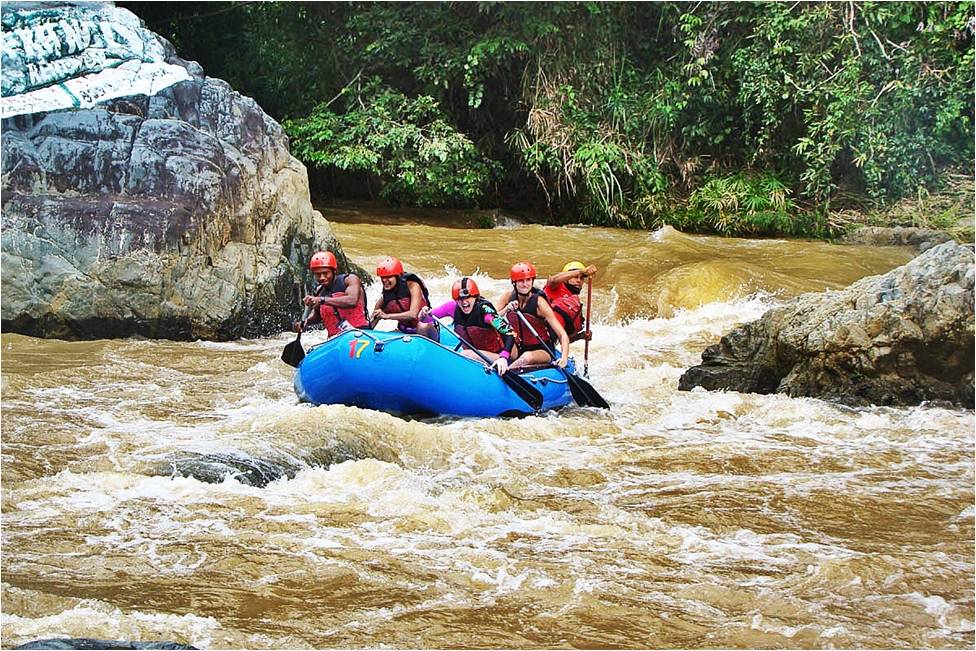
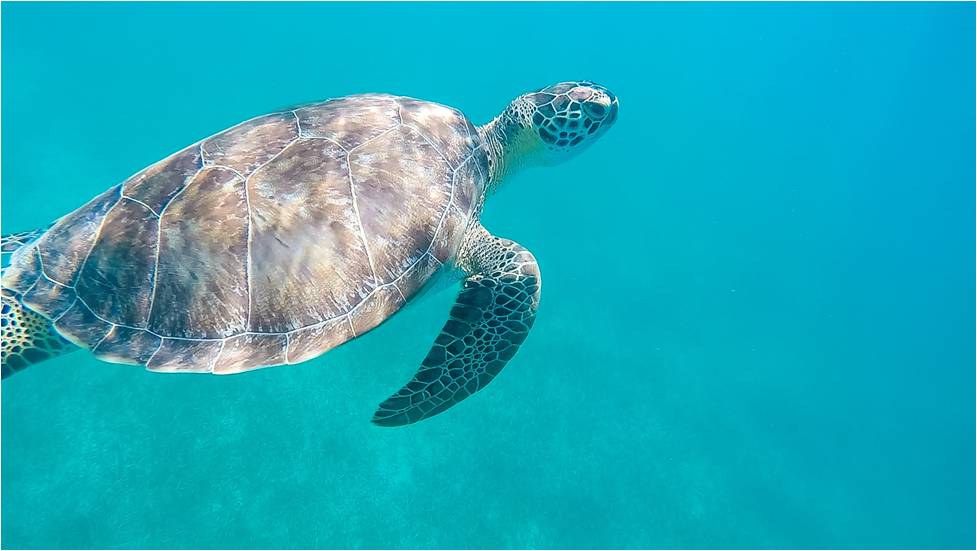
No Comments